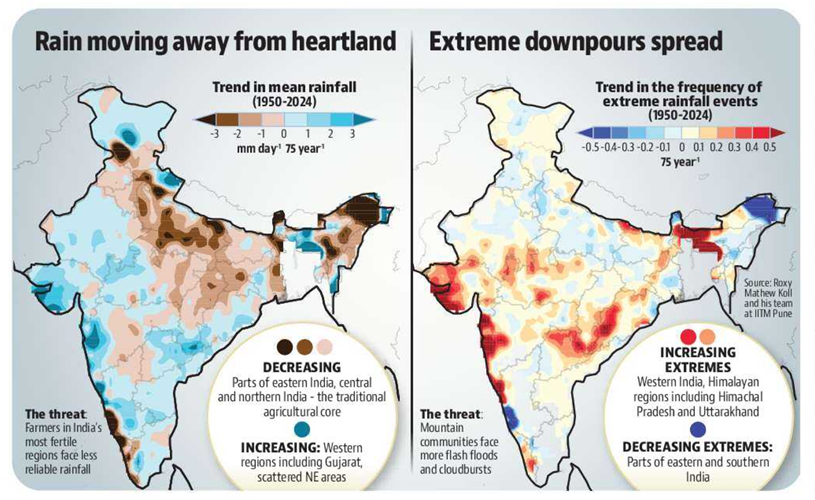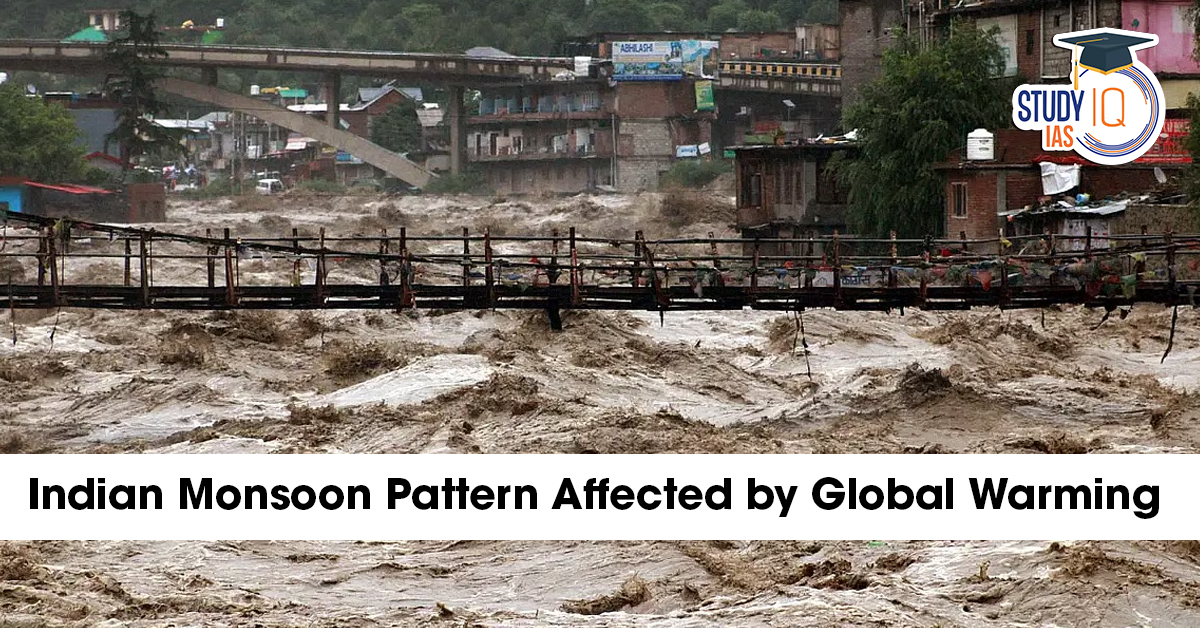Table of Contents
Context: Global warming is making India’s southwest monsoon increasingly unpredictable by weakening traditional circulation patterns and fueling extreme weather with excess atmospheric moisture.
| India’s Southwest Monsoon |
It refers to the seasonal reversal of winds bringing moist air from the Indian Ocean to the Indian subcontinent, causing ~75% of India’s annual rainfall.
|
Causes/Drivers of Monsoon Changes
- Weakened monsoon circulation: Rising sea levels and rising temperatures have disrupted the pressure gradients that traditionally drive monsoon winds.
- Warming and moisture paradox: Increased atmospheric temperatures allow air to hold ~7% more moisture per °C, leading to heavy rain bursts separated by longer dry spells.
- Ocean–atmosphere dynamics: Enhanced ocean warming promotes upward moist air movement over the equatorial ocean, triggering dry descending air (subsidence) over land and inhibiting rainfall.
- Tropical Easterly Jet weakening: The weakening of this jet has contributed to reduced rainfall in central and certain parts of northern India.
- Regional warming effects: Warming in the Middle East and Arabian Sea has intensified pressure gradients, drawing more moisture toward west and northwest India.
- Climate change–driven variability: Climate models predict a surge in extreme rainfall and delayed/unpredictable monsoon onset and progression.
Anthropogenic Causes
- Greenhouse Gas Emissions (Global Warming): Rising CO₂ and other GHGs → increase surface air temperature → Warmer air holds more moisture, causing intense downpours and longer dry spells.
- Aerosols & pollution → reduce sunlight (dimming), alter cloud formation.
- Deforestation & land use change → less evapotranspiration, disturbed local rain cycles.
- Climate Change–Induced Ocean Alterations: Anthropogenic warming has raised Indian Ocean temperatures, shifting circulation patterns (Indian Ocean Dipole) → Weakens Tropical Easterly Jet and monsoon circulation.
Impacts
- Geographic shift in monsoon rains:
- Rain moving away from heartland: Decrease in rainfall over eastern, central, and northern India (traditional agricultural core). Increase in western regions like Gujarat and scattered northeast areas.
- Extreme downpours spread: Increase in western India and the Himalayan regions (Himachal Pradesh, Uttarakhand); decrease in parts of eastern and southern India.
- Intensifying humid heat: Alternating dry and wet spells with high moisture during dry phases increase heat stress on populations.
- Monsoon-linked public health risks: Conditions of >27 °C temperature, moderate rain, and 60‑78% humidity elevate dengue risk.
- Record monsoon extremes (2025): North India experienced its wettest monsoon in 12 years-21% above normal-with record “extremely heavy” rainfall events.
- Glacial and Himalayan risks: Accelerated glacier melt raises flood and landslide risk; monsoon flooding already caused mass casualties.
- Urban flooding & infrastructure stress: Mumbai’s August 2025 rains nearly doubled average monthly totals.

Challenges Ahead
- Forecasting weakening: The weakening traditional links, such as El Niño–monsoon coupling, hinder seasonal prediction.
- Cloudburst monitoring gaps: Extremely sudden, localised cloudbursts (>100 mm/hour) are increasingly deadly but poorly monitored.
- Infrastructure & civic preparedness: Cities struggle to handle flash floods-Hyderabad’s drainage was overwhelmed, despite 155 weather stations and response planning.
- Health & migration: Climate‑linked health burdens (like dengue) and displacement risks rise amid changing monsoon regimes.
Way Forward / Strategic Measures
- Better monitoring & forecasting: Closing gaps in cloudburst detection and seasonal forecasting systems.
- Scientific innovations: AI + satellite data for nowcasting; Doppler radars expansion.
- Public health adaptation: Plan for dengue risk based on temperature and humidity trends.
- Early warning systems & localised planning: Urgent need for granular, tehsil‑level monsoon action plans based on regional variability.
- Urban resilience: Implement climate‑resilient infrastructure: lakes/ponds, clear drains, green spaces; seen as critical after Delhi floods.
- Resilient agriculture: Drought-resistant & flood-tolerant varieties (e.g., Submergence-tolerant rice “Swarna-Sub1”).
- Mitigation-greenhouse gas reductions: Long‑term adaptation must be coupled with aggressive GHG reduction-emissions control remains vital.
- Policy initiatives: Strengthen climate‑resilient agriculture, urban planning, and disaster management under NAPCC and Panchamrit commitments.
- Community awareness & public health outreach: Educate vulnerable communities about heat, health risks (like dengue), and emergency protocols.


 Places in News for UPSC 2026 for Prelims...
Places in News for UPSC 2026 for Prelims...
 Lake Natron: Location, Features, Wildlif...
Lake Natron: Location, Features, Wildlif...
 Erra Matti Dibbalu Added to UNESCO Tenta...
Erra Matti Dibbalu Added to UNESCO Tenta...

























